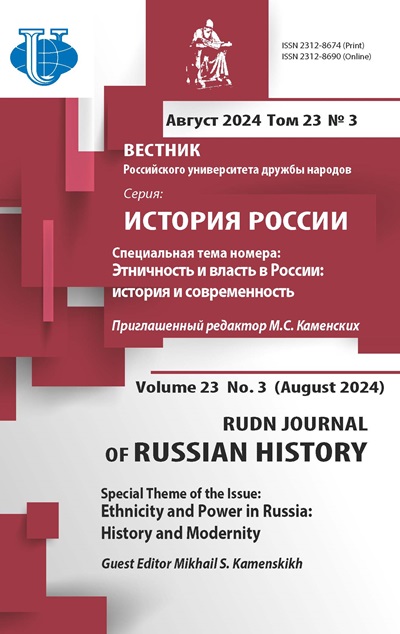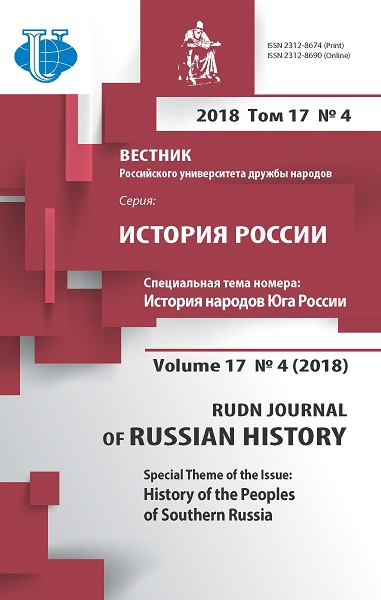Kuban farmers’ attitudes toward Soviet agrarian transformations in the 1920s
- Authors: Fedina I.M1
-
Affiliations:
- Kuban State University
- Issue: Vol 17, No 4 (2018): HISTORY OF THE PEOPLES OF SOUTHERN RUSSIA
- Pages: 792-811
- Section: HISTORY OF THE PEOPLES OF SOUTHERN RUSSIA
- URL: https://journals.rudn.ru/russian-history/article/view/19830
- DOI: https://doi.org/10.22363/2312-8674-2018-17-4-792-811
Cite item
Full text / tables, figures
Abstract
How did the residents of Kuban region perceive the agrarian transformations that the Soviet authorities carried out in the post-revolutionary period? The archival sources studied in this paper reveal the attitude of the villagers to the land and tax policies of the Soviet state, their sentiments towards Soviet modernisation, as well as the relationship between Cossacks and non-residents during the land management campaign. While the history of the Kuban villages in the 1920s has attracted the interest of many researchers and regional historians, the sentiments and attitudes of the population towards the agrarian reforms by the Soviet authorities have so far received little attention. The measures of the Soviet state contributed not only to the eradication of the traditional Cossack culture but also radically altered the socio-economic and cultural profile of the Kuban villages, leading to the loss of Cossack identity. The article analyses the role of the Soviet authorities in the imposition of a socialist order. In the 1920s, their aim was the dissemination of proSoviet sentiments among the Kuban grain farmers. To this end, party and state authorities used various means and methods. Therefore, the study of the sentiments and attitude towards the Soviet authorities’ actions has become an important channel for obtaining information. The Soviet organs attempted to investigate the attitudes of the farmers and took these data in account for adjusting their policies. The documents produced in this process have been a central source for the present article. In the 1920s the authorities launched a largescale ideological project to make the Kuban population accept the Soviet worldview and embrace an archetypical Soviet mentality. In particular the poor and the non-urban population became pillars of social support for the new regime. The mechanisms that the Soviets applied for studying the sentiments of the Kuban grain farmers, together with other instruments of control and coercion, allowed the authorities to conduct a fairly successful Sovietisation campaign in the region, and to attract new proselytes to their side.
About the authors
Irina M Fedina
Kuban State University
Author for correspondence.
Email: ir_Lap@mai.ru
-
149 Stavropolskaya St., Krasnodar, 350040, RussiaReferences
- Babichev, M.M. ‘‘K voprosu o zemel’noy politike Sovetskoy vlasti na Kubani v 1920–1924 gg.’’ [On the Land Policy of the Soviet Government in the Kuban in 1920−1924] Velikiy Oktyabr’ i pervye social’no-ehkonomicheskie preobrazovaniya na Kubani [The Great October and the fi rst socio-economic transformations in the Kuban]. Krasnodar: [S.n.], 1974 (in Russian).
- Belyaeva, M.Y. Familii zapadnyh rayonov Kubani: Morfoderivacionnyy aspect [Surnames of the western districts of the Kuban: Morphoderation aspect]. Stavropol: SGU Publ., 2008 (in Russian).
- Chernopickiy, P.G. ‘‘Sovetskaya vlast’ i kazachestvo’’ [Soviet power and the Cossacks]. Part 1 of Problemy kazach’ego vozrozhdeniya [Problems of the Cossack Revival]. Rostov-on-Don: Rostov-on-Don University Publ., 1996 (in Russian).
- Goldentul, I. Zemel’nye otnosheniya na Kubani: kratkiy ocherk [Land relations in the Kuban: a short essay]. Krasnodar: Tradiciya Publ., 2009 (in Russian).
- Karelin, E.G. “ ‘Zapadnaya oblast’ gosplana: iz istorii ehkonomicheskogo raionirovaniya strany v 1920 gg.” [“Western region of the state plan”: from the history of economic zoning of the country in the 1920s] Rossiyskaya istoriya, no. 10 (2010): 15–18 (in Russian).
- Klenner, I.M. Deystvitel’nost’ kubanskoy stanicy [The validity of the Kuban village]. Krasnodar: Burevestnik Publ., 1924 (in Russian).
- Kondrashin, V.V. Krest’yanstvo i kazachestvo Rossii v usloviyah revolyucii 1917 g. i grazhdanskoj voyny: nacional’no-regional’nyy aspect [The peasantry and the Cossacks of Russia in the conditions of the 1917 revolution and civil war: the national-regional aspect]. Moscow; Saransk: Nauchno-issledovatel’skiy institut gumanitarnykh nauk pri Pravitel’stve Mordovskoy Respubliki Publ., 2017 (in Russian).
- Konyukov, I.A. O rassloenii krest’yanskih hozyajstv Kubani [On the stratifi cation of peasant farms in the Kuban]. Krasnodar: Adygcherkprom Publ., 1928 (in Russian).
- Kucenko, I.Y. Bor’ba partorganizacij Kubani za vovlechenie v socialisticheskoe stroitel’stvo kazach’ego naseleniya v 1920−1925 gg. [The struggle of the Party organizations of the Kuban for involving in the socialist construction of the Cossack population in 1920−1925]. Krasnodar: [S.n], 1963 (in Russian).
- Pankova-Kozochkina, T.V. Kazach’e-krest’yanskoe samoupravlenie epohi NEPa: problemy modernizacii vlastnyh otnosheniy na yuge Rossii [Cossack-Peasant Self-Government of the NEP Age: Problems of Modernization of Power Relations in the South of Russia]. Novocherkassk: Lik Publ., 2014 (in Russian).
- Pankova-Kozochkina, T.V., Bondarev, V.A., and Skorik, A.P. Kazach’e-krest’yanskoe hozyajstvo epohi nehpa: problemy modernizacii agrarnyh otnoshenij na Yuge Rossii [Cossack-Peasant Economy of the NEP Age: Problems of Modernizing Agrarian Relations in the South of Russia]. Novocherkassk: Lik Publ., 2012 (in Russian).
- Pankova-Kozochkina, T.V., Bondarev, V.A., and Skorik, A.P. ‘‘Rabotniki sel’skih sovetov 1920-h gg.: nomenklaturnye podhody bol’shevikov i social’nye trebovaniya krest’yanstva (na materialah yuga Rossii)’’. [Workers of village councils of the 1920s: the nomenclature approaches of the Bolsheviks and the social demands of the peasantry (on the materials of the south of Russia)]. Rossiyskaya istoriya, no. 6 (2011): 136–145 (in Russian).
- Perekhov, Y.A. Kazachestvo i vlast’: poisk konsensusa [Cossacks and power: the search for consensus]. Novocherkassk: Gefest Publ., 1995 (in Russian).
- Polozhenie o socialisticheskom zemleustrojstve i o merah perekhoda k socialisticheskomu zemledeliyu [The Provision on Socialist Land Management and the Measures for the Transition to Socialist Agriculture]. http://www.libussr.ru/doc_ussr/ussr_442.htm (in Russian).
- Rogalina, N.L. ‘‘Zadachi i uroki izucheniya rossijskih agrarnyh reform XX veka.’’ [The tasks and lessons of studying the Russian agrarian reforms of the twentieth century]. Rossiyskaya istoriya, no 4 (2011): 3–13 (in Russian).
- Skorik, A.P. ‘‘Kazaki Yuga Rossii i sovetskaya vlast’ v 1917−1929 gg: vzaimootnosheniya v preddverii ‘velikogo pereloma’.’’ [Cossacks of the South of Russia and Soviet power in 1917–1929: the relationship on the eve of the “great fracture”] Vol. 3 of Kazachestvo Rossii: proshloe i nastoyashchee: Collection of Scientifi c Articles [Cossacks of Russia: past and present]. Rostov-on-Don: Southern Scientifi c Centre of Russian Academy of Science Publ., 2010 (in Russian).
- Skorik, A.P., and Fedina, I.M. Kubanskij hutor: fazy topohromnoj ehvolyucii (konec XVIII – pervaya tret’ XX v.) [Kuban farm: the phases of topochromic evolution (the end of the XVIII − the fi rst third of the XX century)]. Novocherkassk: Lik Publ., 2016 (in Russian).
- Shchetnyov, V.E. ‘‘Kubanskaya stanica do kollektivizacii sel’skogo hozyajstva’’ [Kuban village before the collectivization of agriculture] Velikij Oktyabr’ i pervye social’noehkonomicheskie preobrazovaniya na Kubani [The Great October and the fi rst socioeconomic transformations in the Kuban]. Krasnodar: [S.n.], 1974 (in Russian).
- Uldricks, Teddy J. “Russia and Europe: Diplomacy, Revolution, and Economic Development in the 1920s.” The International History Review, no. 1 (January 1979): 55–83.
- АMVD KK, f. 18, op. 1, d. 10.
- GAKK, f. R-890, op. 1, d. 75 a. GAKK, f. R-102, op. 1, d. 29.
- GAKK, f. R-382, op. 1, d, 255.
- GAKK, f. R-157, op. 1, d. 208.
- CDNI KK, f. 12, op. 1, d. 47.
- CDNI KK, f. 1771, op. 1, d. 318.
- CDNI KK, f. 541, op. 1, d. 6.
- CDNI KK, f. 12500, op. 1, d. 49.
















